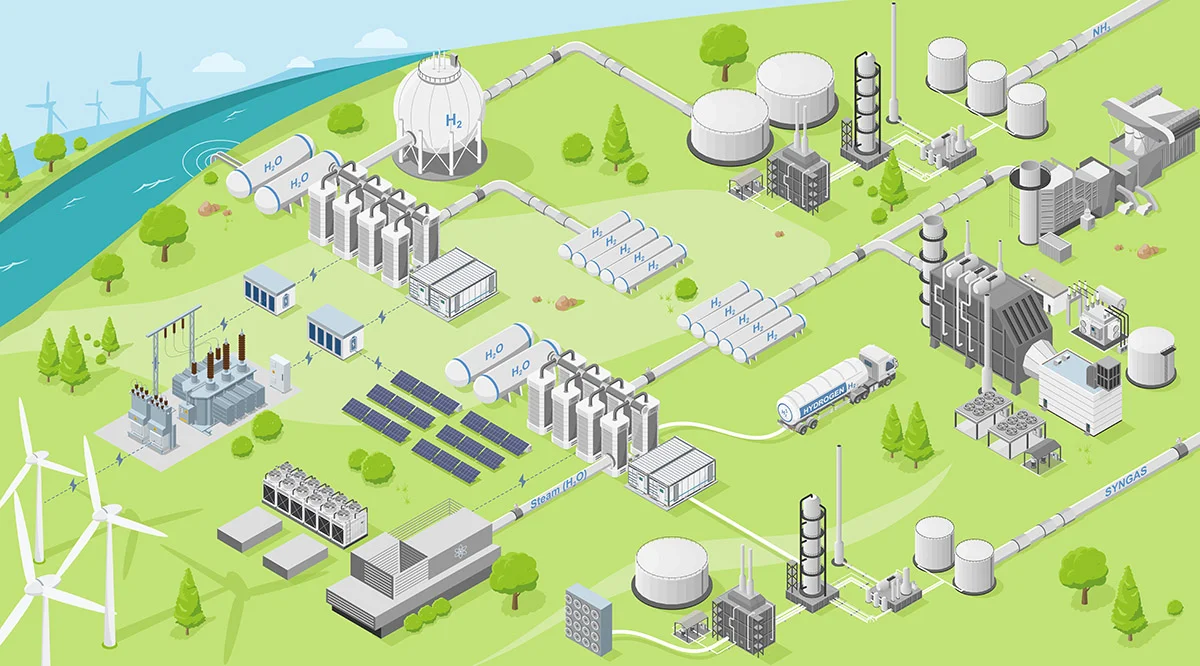Visualizing the value chain
The journey from power to hydrogen
The use of hydrogen requires an integrated system to produce, store, and transport. The production of hydrogen requires integrated systems, and those depend on the desired production process. For example, producing low-carbon-intensity hydrogen (or green hydrogen) requires integrating power generation systems, grid systems, power electronics, and electrolysis. It all works together to create a comprehensive ecosystem.

H2 value chain: Where it stands today
While the complexity of the hydrogen value chain may seem intimidating, GE Vernova is ready to demystify this multifaceted ecosystem. As GE Vernova businesses come together, we continue to collaborate and support our customers in unpacking the challenges surrounding integration, infrastructure, microgrids, and the increased demand driven by green hydrogen production.
Discover
The H2 value chain: How GE Vernova can support your transition
Hydrogen is now widely considered a key step in the energy transition as we work to reduce carbon emissions worldwide. But how do you get from here to there? There are many elements in the hydrogen value chain and GE Vernova has been developing and delivering many of these technologies for decades.
The following are the primary stops along the hydrogen value chain:
Electricity production and storage
Learn more about your zero or low-carbon sources of electricity.
Hydrogen production
Understand the different methods of hydrogen production and technology innovations required to safely produce and use hydrogen.
Hydrogen is produced in several ways, playing into its different roles within the H2 value chain. A color-based convention is used internationally as a form of short-hand nomenclature to name the production pathways—keep in mind, they don't always convey the carbon intensity of the production pathway.
- Grey (or black): Gasification of coal or reforming of natural gas without carbon capture
- Blue: Reforming of methane (SMR) with carbon capture and storage
- Green: Electrolysis of water using renewable power like wind or hydro
- Yellow: Electrolysis of water using solar power.
- Pink (Red): Electrolysis of water using nuclear power
- Turquoise: Pyrolysis of methane which produces hydrogen and solid carbon as a by-product
- White: Gasification or other process using 100% biomass as a feedstock
Storage and transportation
Learn about the inherent challenges and opportunities with storing and transporting hydrogen—and some ways to make it work.
Different forms of hydrogen storage
Hydrogen can be stored either as a gas or a liquid. Storing it as a gas requires high-pressure tanks and storing it as a liquid requires cryogenic temperatures. Hydrogen also can be stored by allowing it to absorb into solids.
Energy storage options
Our pumped hydro storage solutions are a way to store energy at a large scale while helping greatly reduce emissions. Two reservoirs are connected, with one at a higher elevation, and water is pumped into the higher one during times of surplus energy. In times of greater demand, water is released from the upper reservoir, generating energy as it passes through reversible turbines to the lower reservoir.
Our battery energy storage solution offers a new application flexibility and unlocks new business value across the energy value chain. It supports diverse applications including grid reliability and controlled energy flow.
Transportation options for hydrogen
H2 can be transported in cryogenic liquid tanker trucks or gaseous tube trailers. It also may be able to move through pipelines on a much larger scale, provided the infrastructure and policies are in place to support it.
Combustion and power
Learn how much hydrogen is needed for the conversion to energy in a power plant, and the changes to a plant’s equipment that might be required.
Hydrogen has different combustion properties because it’s lighter than natural gas and burns hotter and faster. So, when converting your plant to H2, it’s extremely important to account for how these differences will affect your gas turbines—and the plant overall.
GE has more than 120 gas turbines supporting power generation with hydrogen and associated fuels worldwide, as well as combustion technologies that can operate on a wide range of hydrogen concentrations (up to 100% by volume).
Grid
Discover how the power grid is a critical element in the energy transition as we increase the use of electricity in society.
A key element of the energy transition is the electrification of many sectors, which will require upgrading the existing electrical grid as well as adding new electrical transmission capability. This may include new high voltage direct current (HVDC) systems that allow electricity to be transmitted over larger distances.
We may also see increased use of microgrids, which is a group of interconnected loads and distributed energy resources (DERs) that acts as a single controllable entity with respect to the grid. It can connect and disconnect from the grid to operate in grid-connected or island mode. Microgrids can improve customer reliability and resilience to grid disturbances. We may see these microgrids set-up when integrating renewable energy sources, energy storage, and electrical loads like electrolyzers.
Hydrogen derivatives
Learn how hydrogen is used to create other molecules that can power the energy transition.
Ammonia
Ammonia can be produced from hydrogen using the Haber-Bosch process, which was developed in the 1930's. Ammonia is a key ingredient in the production of fertilizer, which helps feed billions of people each year. Ammonia is also being considered as a possible hydrogen energy carrier. The production of ammonia also requires large amounts of nitrogen, which can be sourced from the atmosphere.
Synthetic fuels
Synthetic fuels, also known as eFuels, can be produced from hydrogen. One eFuel that is seeing growing interest is methanol, which also requires hydrogen. Methanol also requires carbon. This can be sourced from biogenic (natural) sources or it could be pulled from the atmosphere using direct air capture (DAC).
Webinars
Hear from our experts
- Demystifying the hydrogen value chain: Understanding this new ecosystem
- Demystifying the hydrogen value chain: A special focus on Asia
- A Hydrogen Society: What it takes
Contact us
